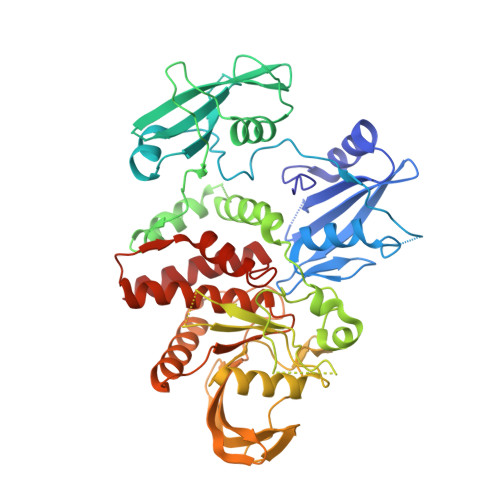Dual Allosteric Inhibition of SHP2 Phosphatase.
Fodor, M., Price, E., Wang, P., Lu, H., Argintaru, A., Chen, Z., Glick, M., Hao, H.X., Kato, M., Koenig, R., LaRochelle, J.R., Liu, G., McNeill, E., Majumdar, D., Nishiguchi, G.A., Perez, L.B., Paris, G., Quinn, C.M., Ramsey, T., Sendzik, M., Shultz, M.D., Williams, S.L., Stams, T., Blacklow, S.C., Acker, M.G., LaMarche, M.J.(2018) ACS Chem Biol 13: 647-656
- PubMed: 29304282
- DOI: https://doi.org/10.1021/acschembio.7b00980
- Primary Citation of Related Structures:
6BMR, 6BMU, 6BMV, 6BMW, 6BMX, 6BMY - PubMed Abstract:
SHP2 is a cytoplasmic protein tyrosine phosphatase encoded by the PTPN11 gene and is involved in cell proliferation, differentiation, and survival. Recently, we reported an allosteric mechanism of inhibition that stabilizes the auto-inhibited conformation of SHP2. SHP099 (1) was identified and characterized as a moderately potent, orally bioavailable, allosteric small molecule inhibitor, which binds to a tunnel-like pocket formed by the confluence of three domains of SHP2. In this report, we describe further screening strategies that enabled the identification of a second, distinct small molecule allosteric site. SHP244 (2) was identified as a weak inhibitor of SHP2 with modest thermal stabilization of the enzyme. X-ray crystallography revealed that 2 binds and stabilizes the inactive, closed conformation of SHP2, at a distinct, previously unexplored binding site-a cleft formed at the interface of the N-terminal SH2 and PTP domains. Derivatization of 2 using structure-based design resulted in an increase in SHP2 thermal stabilization, biochemical inhibition, and subsequent MAPK pathway modulation. Downregulation of DUSP6 mRNA, a downstream MAPK pathway marker, was observed in KYSE-520 cancer cells. Remarkably, simultaneous occupation of both allosteric sites by 1 and 2 was possible, as characterized by cooperative biochemical inhibition experiments and X-ray crystallography. Combining an allosteric site 1 inhibitor with an allosteric site 2 inhibitor led to enhanced pharmacological pathway inhibition in cells. This work illustrates a rare example of dual allosteric targeted protein inhibition, demonstrates screening methodology and tactics to identify allosteric inhibitors, and enables further interrogation of SHP2 in cancer and related pathologies.
Organizational Affiliation:
Novartis Institutes for Biomedical Research , Cambridge , Massachusetts 02139 , United States.


















